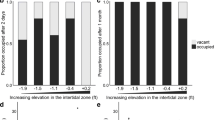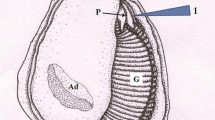Abstract
Although plainfin midshipman (Porichthys notatus) are primarily known for their alternative reproductive tactics, and the dimorphic male subtypes, in which Type-I males demonstrate parental investment and mate attraction, and Type-II males ‘sneak’ fertilization and show no investment after fertilization, little is known about the physiology and tolerance to low aquatic oxygen while nesting in the intertidal zone. In May 2007, females and Type-I and Type-II males were collected, and in June 2009, only Type-I males were collected from nest sites on the coast of Vancouver Island, British Columbia. In the 2007 season, an initial assessment of hypoxia tolerance and nest parameters was recorded for the three subtypes of midshipman. Historical evidence indicates that Type-I males remain on the nest for prolonged periods, and our results suggest they can cope with repeated bouts of aquatic hypoxia by elevating their hematocrit and tolerating high lactate levels. The 2009 season was directed at examining the aquatic hypoxia tolerance of only the Type-I male. Hypoxic (~15 % air saturated water) Type-I males had oxygen consumption rates at ~12 % of the normoxic control (~100 % air saturated water) and a Pcrit, the critical oxygen tension, when a fish switches from oxyregulator to oxyconformer, could not be determined; an indication that these fish are solely oxyconformers. With prolonged exposure to aquatic hypoxia, Type-I males displayed significant elevations in plasma and tissue lactate (heart), tissue glucose (liver), and a depression in gill Na+/K+ATPase and catalase activities. Results suggest that male Type-I midshipman survival in the intertidal zone is enhanced by metabolic depression and tolerance to anaerobic byproducts.




Similar content being viewed by others
References
Arora HF (1948) Observations on the habits and early life history of the batrachoid fish, Porichthys notatus Girard. Copeia 1948:89–93
Baldwin J, Wells RMG (1990) Oxygen transport potential in tropical elasmobranchs from the Great Barrier Reef: relationship between haematology and blood viscosity. J Exp Mar Biol Ecol 144:144–155
Bass AH, Bodnar D, Marchaterre MA (1999) Complementary explanations for existing phenotypes in an acoustic communication system. In: Hauser MD, Konishi M (eds) The design of animal communication. MIT University Press, pp 493–514
Bennett AF, Gleeson TT, Gorman GC (1981) Anaerobic metabolism in a lizard (Anolis bonairensis) under natural conditions. Physiol Zool 54:237–241
Bergmeyer HU (1983) Methods of enzymatic analysis. Academic, New York
Bickler PE, Buck LT (2007) Hypoxia tolerance in reptiles, amphibians, and fishes: life with variable oxygen availability. Annu Rev Physiol 69:145–170
Bradford M (1976) A rapid and sensitive method for the quantitation of microgram quantities of protein utilizing the principle of protein-dye binding. Anal Biochem 72:248–254
Brantley RK, Bass AH (1994) Alternative male spawning tactics and acoustic-signals in the plainfin midshipman fish Porichthys notatus Girard (Teleostei, Batrachoididiae). Ethology 96:213–232
Brantley RK, Tseng J, Bass AH (1993) The ontogeny of inter- and intrasexual vocal muscle dimorphisms in a sound producing fish. Brain Behav Evol 42:336–349
Brauner CJ, Wang T (1997) The optimal oxygen equilibrium curve-a comparison between environmental hypoxia and anemia. Am Zool 37:101–108
Bridges CR (1993) Adaptation of vertebrates to the intertidal environment. In: Eduardo J, Bicudo PW (eds) The vertebrate gas transport cascade-adaptations to the environment and mode of life. CRC Press, Boca Raton, pp 12–22
Chippari-Gomes AR, Gomes LC, Lopes NP, Val AF, Almeida-Val VMF (2005) Metabolic adjustments in two Amazonian cichlids exposed to hypoxia and anoxia. Comp Biochem Physiol B 141:347–355
Clairborne A (1985) Catalase activity. In: Gunwald RA (ed) CRC handbook of methods for oxygen radical research. CRC Press, Boca Raton, pp 283–284
Clausen T, van Hardeveld C, Everts ME (1991) Significance of cation transport in control of energy metabolism and thermogenesis. Physiol Rev 71:733–774
Coleman RM (1999) Parental care in fishes. In: Horn MH, Martin KLM, Chotkowski MA (eds) Intertidal fishes: life in two worlds. Academic, New York, pp 165–180
Felton GW (1995) Oxidative stress of vertebrates and invertebrates. In: Ahmad S (ed) Oxidative stress and antioxidant defense in biology. Chapman and Hall, New York, pp 356–434
Fitzpatrick JL (2008) Sperm competition in fish. Disseration, McMaster University
Fitzpatrick JL, Craig PM, Bucking C, Balshine S, Wood CM, McClelland GB (2009) Sperm performance under hypoxic conditions in an intertidal fish (Porichthys notatus). Can J Zool 87:464–469
Guppy M, Withers P (1999) Metabolic depression in animals: physiological perspectives and biochemical generalizations. Biol Rev 74:1–40
Hastings D, Burggren W (1995) Developmental changes in oxygen consumption regulation in larvae of the South African clawed frog Xenopus laevis. J Exp Biol 198:2465–2475
Hochachka PW, Buck LT, Doll CJ, Land SC (1996) Unifying theory of hypoxia tolerance: molecular metabolic defense and rescue mechanisms for surviving oxygen lack. PNAS 93:9493–9498
Hubbs CL (1920) The bionomics of Porichthys notatus Girard. Am Nat 54:380–384
Ivancic I, Degobbis D (1984) An optimal manual procedure for ammonia analysis in natural waters by the indophenol blue method. Water Res 18:1143–1147
Lushchak VI, Lushchak LP, Mota AA, Hermes-Lima M (2001) Oxidative stress and antioxidant defenses in goldfish Carassius auratus during anoxia and reoxygenation. Am J Physiol Regul Integr Comp Physiol 280:R100–R107
Martin KLM (1993) Aerial release of CO2 and respiratory exchange ratio in intertidal fishes out of water. Environ Biol Fish 37:189–196
Martin KLM, Bridges CR (1999) Respiration in water and air. In: Horn MH, Martin KLM, Chotkowski MA (eds) Intertidal fishes: life in two worlds. Academic, New York, pp 54–78
Martin KLM, Strathman RA (1999) Aquatic organisms, terrestrial eggs: early development at the water’s edge. Am Zool 39:215–217
Martin KLM, Van Winkle RC, Drais JE, Lakisic H (2004) Beach-spawning fishes, terrestrial eggs, and air breathing. Physiol Biochem Zool 77:750–759
McCormick SD (1993) Methods for the nonlethal gill biopsy and measurements of Na+, K + -ATPase activity. Can J Fish Aquat Sci 50:656–658
McDonald MD, Walsh PJ (2007) Aglomerular kidney function when challenged with exogenous MgSO4 loading or environmental MgSO4 depletion. J Exp Zool 307A:676–687
Meka JM, McCormick SD (2005) Physiological response of wild rainbow trout to angling: impact of angling duration, fish size, body condition, and temperature. Fish Res 72:311–322
Perry SF, Braun MH, Genz J, Vulesevic B, Taylor J, Grosell M, Gilmour KM (2010) Acid–base regulation in the plainfin midshipman (Porichthys notatus): an aglomerular marine teleost. J Comp Physiol B 180:1213–1225
Pörtner HO, Grieshaber MK (1993) Critical PO2(s) in oxyconforming and oxyregulating animals: gas exchange, metabolic rate and the mode of energy production. In: Eduardo J, Bicudo PW (eds) The vertebrate gas transport cascade: adaptations to environment and mode of life. CRC Press, Boca Raton, pp 330–357
Rahmatullah M, Boyde TR (1980) Improvements in the determination of urea using diacetyl monoxime; methods with and without deproteination. Clin Chim Acta 107:3–9
Rifkind JM, Abugo O, Levy A, Monticone R, Heim J (1993) Formation of free radicals under hypoxia. In: Hochachka PW, Lutz PL, Rosenthal M, Thillart GVD (eds) Surviving hypoxia: mechanisms of control and adaptation. CRC Press, Boca Raton, pp 509–535
Sadler J, Wells RMG, Pankhurst PM, Pankhurst NW (2000) Blood oxygen transport, rheology and hematological responses to confinement stress in diploid and triploid Atlantic salmon, Salmo salar. Aquaculture 184:349–361
Scholander PF, Bradstreet E, Garey WF (1962) Lactic acid response in the grunion. Comp Biochem Physiol 6:201–203
Scott GR, Wood CM, Sloman KA, Iftikar FI, De Boeck G, Almeida-Val VMF, Val AL (2008) Respiratory responses to progressive hypoxia in the Amazonian oscar, Astronotus ocellatus. Respir Physiol Neurobiol 162:109–116
Storey KB (2007) Anoxia tolerance in turtles: metabolic regulation and gene expression. Comp Biochem Physiol A Mol Integr Physiol 147:263–276
Thompson EM, Nafpaktitis BG, Tsuji FI (1988) Latitudinal trends in size dependence of bioluminescence in the midshipman fish Porichthys notatus. Mar Biol 98:7–13
Truchot JP, Duhamel-Jouve A (1980) Oxygen and carbon dioxide in the marine intertidal environment: diurnal and tidal changes in rockpools. Respir Physiol 39:241–254
Walker HJ Jr, Rosenblatt RH (1988) Pacific toadfishes of the genus Porichthys (Batrachoididae) with descriptions of three new species. Copeia 1988:887–904
Walsh PJ, Wang Y, Campbell CE, De Boeck G, Wood CM (2001) Patterns of nitrogenous waste excretion and gill urea transporter mRNA expression in several species of marine fish. Mar Biol 139:839–844
Yeager DP, Ultsch GR (1989) Physiological regulation and conformation: a BASIC program for the determination of critical points. Physiol Zool 62:888–907
Acknowledgments
The authors wish to thank the staff at the Bamfield Marine Sciences Centre (BMSC) for their help and cooperation during this study. We are particularly indebted to the research coordinator Bruce Cameron for his helpful assistance. Additional thanks are extended to Carol Bucking, Karlee Craig, Risa Smith, Sue Walsh, and Tom Mommsen for the assistance in field collection of midshipman. This work was funded by a Natural Sciences and Engineering Research Council of Canada (NSERC) Discovery Grants to CMW and PJW, an NSERC Discovery Grant and an Ontario Ministry of Innovation Early Research Award to GBM, and a Canadian Society of Zoologists Student Travel Research Grant to JLF. Both JLF and PMC were recipients of NSERC postgraduate scholarships. CMW and P JW are supported by the Canada Research Chair Program. This research was approved by the Animal Care Committee at BMSC and animals were collected under permits from the Department of Fisheries and Oceans Canada.
Author information
Authors and Affiliations
Corresponding author
Rights and permissions
About this article
Cite this article
Craig, P.M., Fitzpatrick, J.L., Walsh, P.J. et al. Coping with aquatic hypoxia: how the plainfin midshipman (Porichthys notatus) tolerates the intertidal zone. Environ Biol Fish 97, 163–172 (2014). https://doi.org/10.1007/s10641-013-0137-3
Received:
Accepted:
Published:
Issue Date:
DOI: https://doi.org/10.1007/s10641-013-0137-3




